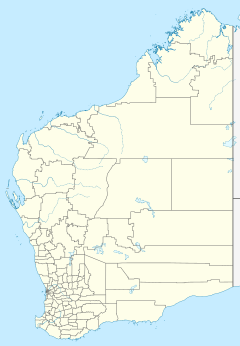Mardie Station facts for kids
Mardie Station is a very large farm, called a pastoral lease, in Western Australia. It started in 1866. First, it raised sheep, but later it switched to raising cattle. It's located in the Pilbara region, near where the Fortescue River flows into the ocean.
Contents
History of Mardie Station
How Mardie Station Started
Mardie Station was first set up by Simpson and MacIntoch. They worked for a company called Denison Plains Pastoral Company. They planned to sail a ship named Warrier from Melbourne to another area called Roebuck Bay.
But the ship had trouble with calm winds. The animals they were carrying started to get very thirsty. So, they had to land at a place called Cossack.
After landing, the group decided to travel southwest. They found a place with springs and decided to settle there. This is how Mardie Station began. By 1883, the station had fences, wells, and about 18,000 sheep.
Changing Owners and Animals
The Murray Squatting Company bought Mardie Station in 1883. They paid a good price for it. One of the owners, Richardson, kept an interest in Mardie for 30 years.
Later, the Withnell family owned the station. They owned many other large farms in the North West region.
In 1913, James Withnell, who owned another station, bought Mardie. At that time, it was about 397,500 acres (160,860 hectares) and had 19,000 sheep.
In 1923, James Withnell sold Mardie Station to B. H. Sharpe for £50,000. It came with 30,000 sheep and 100 cattle.
Mardie Station changed from raising sheep to raising cattle in 1998. Since 2007, it has been owned by CITIC Pacific, a company from Hong Kong.
Size and Challenges
Today, Mardie Station covers about 225,000 hectares (556,000 acres). It has more than 8,000 specially bred cattle.
The station has faced challenges like big floods. In 1894, the Fortescue River flooded badly. The water came very close to the main house, and hundreds of sheep were washed away.
More recently, the station had heavy rains and floods during Cyclone Monty in 2004 and again in 2009. Fences were washed away, roads were cut off, and cattle were stuck.
Mesquite Plants and Mining
Mardie Station has a big problem with a plant called mesquite. Two mesquite trees were planted for shade in the 1930s. Now, about 150,000 hectares (370,000 acres) of the station have this plant. It's a problem because it can spread easily.
The station is also home to a huge mining project. A Chinese company, Sino Iron, is digging for magnetite at Mardie. They are planning an open cut mine that will be 5.5 kilometres (3.4 miles) long, 3 kilometres (1.9 miles) wide, and hundreds of metres deep. This mine is one of the largest holes ever dug on Earth!
Climate at Mardie Station
Mardie Station has a very hot and dry climate. This means it has extremely hot summers and very warm winters.
Temperatures
The average highest temperatures range from about 27.8°C (82°F) in July to 37.9°C (100°F) in January.
On February 19, 1998, Mardie recorded a temperature of 50.5°C (122.9°F). At that time, this was the highest temperature ever recorded in Western Australia. It was also the second-highest temperature ever recorded in Australia.
Mardie's record for Western Australia was broken on January 13, 2022, when another town, Onslow, reached 50.7°C (123.3°F). Mardie also reached 50.5°C again on the same day.
Rainfall and Wind
Rainfall at Mardie is usually low and can change a lot. For example, 364.0 mm (14.3 inches) of rain fell in just 24 hours on February 10, 1995. But in the whole year of 1936, only 8.7 mm (0.34 inches) of rain fell.
On February 19, 1975, during Cyclone Trixie, Mardie Station recorded very strong wind gusts. They were at least 259 kilometres per hour (161 mph). This was the highest wind gust recorded in Australia at that time.
| Climate data for Mardie | |||||||||||||
|---|---|---|---|---|---|---|---|---|---|---|---|---|---|
| Month | Jan | Feb | Mar | Apr | May | Jun | Jul | Aug | Sep | Oct | Nov | Dec | Year |
| Record high °C (°F) | 50.5 (122.9) |
50.5 (122.9) |
47.2 (117.0) |
43.7 (110.7) |
40.5 (104.9) |
35.4 (95.7) |
34.5 (94.1) |
39.0 (102.2) |
41.0 (105.8) |
46.0 (114.8) |
47.0 (116.6) |
48.8 (119.8) |
50.5 (122.9) |
| Mean daily maximum °C (°F) | 37.9 (100.2) |
37.4 (99.3) |
37.6 (99.7) |
35.9 (96.6) |
31.5 (88.7) |
28.2 (82.8) |
27.8 (82.0) |
29.6 (85.3) |
32.3 (90.1) |
35.0 (95.0) |
36.4 (97.5) |
37.6 (99.7) |
33.9 (93.0) |
| Mean daily minimum °C (°F) | 25.1 (77.2) |
25.4 (77.7) |
24.3 (75.7) |
21.2 (70.2) |
17.0 (62.6) |
14.0 (57.2) |
11.9 (53.4) |
12.5 (54.5) |
14.5 (58.1) |
17.6 (63.7) |
20.2 (68.4) |
23.1 (73.6) |
18.9 (66.0) |
| Record low °C (°F) | 16.1 (61.0) |
17.3 (63.1) |
13.3 (55.9) |
10.0 (50.0) |
7.8 (46.0) |
3.9 (39.0) |
2.9 (37.2) |
4.4 (39.9) |
6.0 (42.8) |
7.6 (45.7) |
12.8 (55.0) |
14.8 (58.6) |
2.9 (37.2) |
| Average rainfall mm (inches) | 37.9 (1.49) |
62.6 (2.46) |
48.9 (1.93) |
19.3 (0.76) |
36.5 (1.44) |
37.1 (1.46) |
13.8 (0.54) |
7.0 (0.28) |
1.3 (0.05) |
0.8 (0.03) |
1.4 (0.06) |
9.3 (0.37) |
275.9 (10.87) |
| Average rainy days (≥ 0.2 mm) | 3.1 | 4.2 | 3.1 | 1.4 | 2.8 | 3.1 | 1.7 | 1.0 | 0.2 | 0.2 | 0.3 | 0.9 | 22 |
| Source 1: Bureau of Meteorology | |||||||||||||
| Source 2: The Guardian | |||||||||||||


